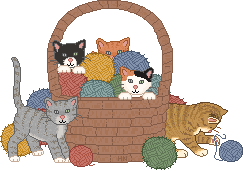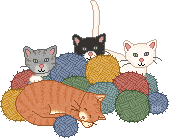Updated 1/31/04

When a cat sits with both feet tucked inward and studies you with the same admiration you would direct toward a Rembrandt, you know you have been adopted.

There are over sixty million cats in the United States. Cats have surpassed dogs in popularity, most likely because they can be happily maintained indoors, and are affectionate and clean.
 
The Litterbox
For all kinds of problems and questions associated with litterboxes and elimination problems, you must visit CatsInternational.org . Here you will find lots of excellent information about litterbox problems, types of litter, spraying and marking, and even how to clean up stains.
There is a new litter that helps cats who have litter box avoidance problems actually want to use the box instead of your carpet. Cat Attract kitty litter has unique herbal scent that attracts the cat's curiosity and the right texture for their paws. Although you may not be aware of Cat Attract’s scent, your cat will. I have it on the good word of a friend that this works!

Most beds sleep up to six cats. Ten cats without the owner.
~Stephen Baker~

Feline Trivia
- On average, cats can jump five times as high as their tail is long.
- The domestic cat is the only feline species able to hold his tail vertically while walking.
- A cat's brain is more similar to a human's than a dog's, both having similar areas responsible for emotion.
- People who are allergic to cats are actually allergic to their saliva - more so than their dander.
- A cat's heart beats 110-140 beats per minute, about twice as fast as the human heart.
- A cat has 230 bones in its body. A human has only 206.
- A mother cat is pregnant for 63 to 65 days.
- It has been scientifically proven that stroking a cat can lower one's blood pressure.
- Every cat has a nose print as unique and individual as a human fingerprint.
- Scientists who study these things have determined that cats have about 100 different vocalizations, compared to dogs who have only around 10.
- Purring does not always mean that a cat is happy. Some cats will purr loudly when they are in pain.
- Of every 3,001 Calico kittens born, 3,000 are females.
- A cat has 130,000 hairs per square inch on its belly.
- A cat has 13 ribs.
- Only 2/3 of cats respond to the catnip plant
 
Flea Facts
- Fleas have spikes on their bodies that allow them to stick to the fur (making them harder to remove from your pets.)
- Fleas can jump more than six inches high, the equivalent of a human jumping 350 feet.
- Female fleas can ingest up to 30 times their own wieght in blood.
- There are 2,200 species of fleas.
- A flea will spend an average of two months on a pet, and up to eight months living in the animal's environment.
How much do you really know about fleas?
Try the Flea Facts Trivia Game .

If the human eye was proportionately the same size as the cat's, we would all look like Margaret Keane paintings. Using the feline ratio, the human eye would be about eight inches in diameter.
 
Right or Left?
Scientists have conducted extensive studies to determine whether cats are right-handed or left-handed. The results are in! 40% of cats are right-handed, 20% are left handed, 40% are ambidextrous.
You can find out in which category your cat falls by conducting simple tests. To be accurate, watch his activities over a period of time, not just once or twice. The dominant paw will become evident.
When you play with your cat, roll his ball to him first slightly to the left, then slightly to the right. Does he usually reach for the ball with the same foot or does he use each foot equally?
Now, toss a toy to him. Does he catch it with one foot more often than another?
The third test, and often a defining test, is to watch him in his litter box. When he is covering his "job," does he use one paw more than the other?
These are simple tests, not nearly as extensive as the scientists who made the original findings. But they will give you a good idea whether your feline is a righty or lefty.
From Nose-to-Toes, A Publication for Pet Lovers.

Some bowls, especially plastic, have an odor that may not be detectable by humans but that can be offensive to felines. Always use glass, ceramic or stainless steel dishes for your kitty, wash them daily, and rinse thoroughly.
 
Cat Weather Lore
- A sneezing cat means rain on the way, and three sneezes in a row portends a
cold for the cat's human!
- A cat running wildly about, darting here and there and clawing everything in
sight means wind or a storm is on the way; when the cat quiets down, the
storm will soon blow itself out.
- Cats washing over their ears has long been held to foretell rain; the old
rhyme goes 'When Kitty washes behind her ears, we'll soon be tasting heaven's tears.
- A cat which rolls over and over in the grass, claws the ground and behaves
in a skittish manner, is indicating that a brief rain-shower is on the way.
- When the cat is restless and moves from place to place without settling, it
is foretelling hard winds.
- A cat who sits with its back to the fire is said to be a portent of frost.
- When a cat spends the night outdoors and caterwauls loudly, it may be
foretelling a period of several days' bad weather.

People who don't love cats were probably mice in an earlier life!

Cats average 18 hours of naps in every 24 hours. So, a 9-year old cat has actually been awake for only about three years!
Note: On this one I would have to disagree - especially where the Tuxedo is concerned. My Delli and my sister's Oscar (both Tuxedos) seem to have this one reversed. It seems as if they are always awake and nap very little. They are much too busy to waste time sleeping. Now Izzy, I can believe it. Spottie, hard to say since she's up prowling around all night opening drawers, closet doors, and looking for new hiding places. Sam, no question - he does sleep that much.
 
Fraid E. Cat never caught a mouse.
  
You can't trust a d*g to watch your food.
  
Never hold a Dust-Buster and a cat at the same time.
 
The feline sense of smell is often referred to as smell tasting. It is technically called flehman. Cats use their Jacobson's Organ, a "sense organ in their gums that can be activated by chemical stimuli and store up scents." When taking in a new scent, the cat opens his mouth and slightly pulls back his uper lip. This allows the cat's sense of smell to take a picture of each new scent.

How sensitive are a cat's whiskers? They are so sensitive that if they move even 1/200th of the width of a human's hair, they will send signals to the cat's brain. Whiskers develop on the feline fetus even before other body hair and they are fully functional when the kitten is born.

Statistics have shown that domestic cats are successful in catching mice in one out of three attempts. Feral cats have a higher average, catching their prey at an average of two in every five tries.

Grooming
When cats are not sleeping, hunting or eating, they are likely to be primping meticulously. Felines, wild and domestic, are believed to spend up to one-third or more of their waking hours on preening. Far from being a vain preoccupation with appearance, however, the self-grooming vigilance of cats is natural, reflexive behavior that is vital to their hygiene, health and comfort.
Grooming begins at the moment of birth. Immediately after delivering their litters, both wild and domestic females lick off the layer of membranes covering each cub or kitten, simultaneously cleaning and warming the newborns. By 2 or 3 weeks of age, the youngsters have the physical skills and the motivation to groom themselves.
The papillae-spiked tongue is a feline's primary grooming tool. The moistening saliva and rough tongue work together to scrub and align the hairs of its coat. And thanks to the incredible suppleness of its spine, a cat can lick almost every part of its body, except for the head, face and between the shoulder blades. To clean these places, cats lick their paws and then rub them over the face and head. If frustrated by a particularly rough, sticky or dirty patch on its coat, a cat may resort to using its teeth to tear or bite off the offensive material, along with the hairs.
As a consequence of all this grooming, felines ingest a considerable amount of dead hair, which they occasionally vomit as hairballs. Longhair domestic breeds are prone to impaction of hair in the intestinal tract and may need regular doses of a hairball remedy to avoid serious problems. Frequent grooming of both longhair and shorthair cats by their guardians helps to prevent problems by removing loose hair before it is swallowed.
Grooming also regulates body temperature. In warm weather, the saliva acts as a coolant that can reduce a cat's body heat by as much as one-third. In lower temperatures, the rake-like tongue aligns the hairs of the coat so that they retain heat and keep out the cold.
A cat's saliva contains a natural cleaning and deodorizing agent that helps to maintain his fur's health and keep it fresh smelling.
Depositing saliva on the coat has yet another interesting purpose. When cats scent themselves with their own saliva, it may relieve anxiety, offering a source of reassurance at tense moments. Cats appear to dispel fear, nervousness and pain by seemingly inappropriate or frantic grooming, much like human displacement behaviors such as nail biting or other nervous habits. Impromptu preening, for instance, often follows a domestic cat's fall after a poorly timed jump.
Cats have a special order to their procedure of grooming. It is called autogroom. They almost always follow the same procedure:
- First the head and face
- Then the front legs, shoulders, sides and hind area
- Then the tail, from base to tip.
 
Warning Signs of Dental Disease
Consult your veterinarian if your cat exhibits any of these symptoms:
- Drooling
- Dropping Food
- Red or bleeding gums
- Foul breath
- Pawing at the mouth
- Tilting the head when eating
- Not eating, hissing at food
- Not chewing but gulping down food
- Not wanting hard food or the regular foods kitty used to enjoy.

A Cat's Coat
Cats can have three kinds of hair in their coats — down, awn, and guard.
The down is the shortest, finest, and softest hair. The awn is the
coarsest, and the guard (sometimes called the primary hairs) is the
longest. Not all cats have all three varieties. The Sphynx has only down
hairs, and few of these. The Cornish Rex has only awn and down. The awn
hairs are usually shorter than the guard hairs (and longer than the down),
but when awn and guard hairs are the same length, as in the Russian Blue,
the cat is called double coated.

 







The contents of this site are copyright© 2000-2004, Jackie Edwards/Jacqlee (The Cat Lady). All Rights Reserved.
|